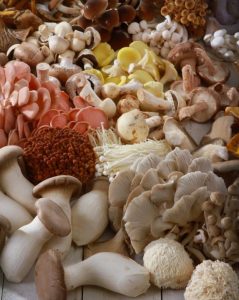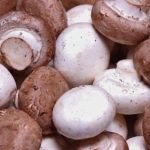Behind every fresh, organic vegetable in your Market Box is the hard work and dedication of our farm family—and that includes the youngest members of our team!
Get a special behind-the-scenes look as our farm kids roll up their sleeves and plant onions in the field, a task that marks the beginning of our growing season.
These onions, along with so many other seasonal veggies, are the foundation of the wholesome produce you’ll receive—especially when you join our Weekly Salad Greens Subscription in the Lehigh Valley, designed to bring fresh, local greens to your table each week.
As the season unfolds, we’ll help you make the most of the harvest with tips for using the fresh greens and veggies we’re growing.
Today we’re sharing how you can get your hands on the right supplies to start your own gardening journey, plus some delicious meal ideas to highlight the greens you’ll find in your weekly bundle.
Keep reading for a dose of inspiration—from garden prep to farm-to-table recipes that nourish your family! 🌱
FEATURED: Seeds for your Garden, Soil, and Trays 🌱
Whether you’re a new or experienced gardener, we can help you get your growing season started.
Farmer Reuben recommends that every family Grows One Thing each season. That’s not a huge commitment and the experience keeps you grounded and connected to real life.
What to plant? If your soil is ready, plant radish, lettuce, kale, arugula, turnips, peas, spinach and mesclun mix. Start your peppers, watermelon, cherry tomatoes indoors in seed trays with potting soil so they’ll be ready to plant in late May.
Visit the “Garden” section of our online store or stop by the General Store to explore our collection of seeds, potting soil, and seedling starter trays!
FEATURED: Weekly Salad Greens Subscription in the Lehigh Valley.🥬
Our weekly Greens Bundle Subscription is just the thing you need to make sure you have fresh, healthy greens on your table!
Each week, we select the best seasonal greens for you.
They’re loaded with nutrients and perfect for making flavorful spring salads.
Your subscription includes 2 bags of loose greens (usually 6 oz. or more) or heads of lettuce. You make your selection from what’s available each week – and at this time of year, more varieties are becoming available week by week!
With plenty of fresh spring greens on hand, you’ll need some salad ideas.
Read below for tips and suggestions for making great salads. And of course, you’ll need great salad dressings, too.
Learn how to make your own homemade dressings with our simple formulas for Homemade Spring Salad Dressings.
MEAL IDEAS FOR YOUR LOCAL ORGANIC FOOD THIS WEEK:
Many of these recipes include produce or other items you may have received in your market box. You may also see ingredients you can purchase at the WHF General Store. Experiment and see what you can use to create your meal plan!
💡Pro tip: Always check your recipes to see what you have and what you need to purchase. Takes a few extra minutes in planning, but it beats finding out at the last minute that you’re missing ingredients!
It’s spring greens season! And that means it’s time for spring salads made with fresh, local organic veggies.
To build a great salad, you don’t need a recipe; you just need a simple formula and a willingness to experiment. Here’s a simple starting point so you can mix, match, and customize your salads all season long!
🥗Build a Salad: The Simple Spring Formula
- Base 🍃🥬
Start with spring greens, cabbage, spinach, or cooked grains like farro or quinoa.- Something Crunchy 🥒🥜
Add toasted nuts or seeds, sliced radish, croutons, or crispy chickpeas for texture.- Something Soft 🧀🥑
Balance it with avocado, roasted veggies, fresh berries, soft cheese, or a soft-boiled egg.- Protein 🍗🥩
Make it satisfying with grilled chicken, shrimp, tofu, beans, lentils, or even leftover steak.
- 💡Tip: Use your leftover whole roasted chicken meat!
- Something Unexpected 🎉🍓
Keep it interesting—try pickled onions, fresh herbs, a spoonful of jam, or a splash of balsamic or cherry liqueur.- Dressing 🥄🍋
Toss it all with a vinaigrette or creamy dressing that fits the vibe—or the season.Seasonal Variations 🌺🍂
As the seasons change, so can your salad! In spring and summer, focus on fresh herbs, berries, and citrus. Fall and winter call for roasted root veggies, hearty greens, and richer dressings. Adjust the protein and crunch factor depending on what’s fresh at the market or in your fridge!
But if you do prefer a good recipe, here are a few to try:
- Everything Spring Green Salad with Basil Lemon Vinaigrette is filled with fresh seasonal produce, olives, sunflower seeds, and more. Enjoy as a main meal, side dish, or potluck contribution.
- Check out this article with Three Spring Salads to try. You’ll find a yummy kale salad with mango, celery, avocado, sunflower seeds, and golden raisins. There’s also a baby kale salad with radishes, snap peas, strawberries, celery, and dried cranberries.
- How about a Steak and Strawberry Salad? This salad has plenty of protein and a nice sweet/savory balance. It would make an elegant springtime dinner. And the Strawberry Balsamic Poppyseed Dressing that’s included looks amazing!
- Smoked Salmon Salad with Dill Dressing is a light and refreshing dish that’s beautiful to look at! Perfect for a potluck gathering.
- Think leafy greens aren’t your favorite? Swiss Chard with Cannellini Beans and Caramelized Onions might be the recipe that makes you change your mind. This is a warm dish, but we say it still counts as a salad!
- 💡Tip: Other beans work great here, too, so use what you have on hand.
- Try this light yet filling Lemony Farro and Shaved Asparagus Salad with Feta. Just a few simple ingredients give you tons of flavor and the perfect contrast of textures.
- Salad for breakfast? Absolutely!
- Try this Best Breakfast Salad with all you’d expect from breakfast – eggs, potatoes, bacon or sausage plus your leafy greens!
- Or make a Healthy Breakfast Salad that includes sausage meatballs along with greens, eggs, and veggies for something really different!
- If a Savory Breakfast Salad is more your style, you’ll love this one with sweet potatoes, hummus, and blueberries.
MEAT AND SEAFOOD:
- Chicken, steak, shrimp, and salmon all make great protein choices for dinnertime main dishes. Then use your leftovers for a protein option in your lunch salads.
- 💡Tip: Buy a little more than you might normally make for a meal so you can cook once and eat twice!
- 💡Tip: Make our Farm Fresh Herb Roasted Chicken recipe at the start of the week and use roasted chicken meat in your salads.
DAIRY:
- Add yogurt to your market box for mixing up creamy salad dressings. (Oh, and it’s great for breakfast or a snack, too!)
- Feta or goat cheese adds a tangy element to your spring salads. We also have a full roster of firm cheeses to choose from.
- Eggs are a fantastic option for adding nutrient-dense protein to your salads.
- 💡Tip: Boil several eggs at the beginning of the week to keep on hand for quick salad prep.
BREAD:
- There’s nothing like warm, farm-made sourdough bread to serve alongside your salads. Make sure to add a loaf (or two!) when you place your market box order.
PANTRY RECOMMENDATIONS:
- Shrubs are great for making mocktails and cocktails, but they also make great salad dressings!
- 💡Tip: Try this simple Shrub Vinaigrette from our friends at Tait Farms: 2 Tbs. Tait Farm Shrub, 1 tsp. Dijon mustard, 1/4 tsp. salt, 1/4 tsp. black pepper, 1 small clove garlic, finely minced, 6 Tbs. oil. Whisk all the ingredients together until emulsified.
- We have so many terrific ingredients and mix-ins for your salads and homemade salad dressings!
- juices, shrubs
- vinegars, olive oil
- nuts, seeds, and dried fruits
- herbs and spices
- olives, pickles, and ferments
- tahini, nut butter
- jams and preserves
- a variety of dried beans
FRUIT:
Storage for all apple varieties:
Keep unwashed apples in a plastic bag in the refrigerator’s crisper drawer, where they can stay fresh for up to two weeks.
 Apple, Crimson Topaz – Crimson Topaz is a striking red apple with a tangy-sweet flavor, originally bred in the Czech Republic and now grown in small quantities elsewhere. It’s an organic grower’s favorite thanks to its natural disease resistance. Nutritionally, it’s similar to other apples – low in calories, high in fiber, and rich in vitamin C and antioxidants from its deep red skin. Crimson Topaz apples are great for fresh eating if you like a sharper bite, and they add depth to salads and cheese boards. They also bake beautifully, adding tartness to pastries and tarts.
Apple, Crimson Topaz – Crimson Topaz is a striking red apple with a tangy-sweet flavor, originally bred in the Czech Republic and now grown in small quantities elsewhere. It’s an organic grower’s favorite thanks to its natural disease resistance. Nutritionally, it’s similar to other apples – low in calories, high in fiber, and rich in vitamin C and antioxidants from its deep red skin. Crimson Topaz apples are great for fresh eating if you like a sharper bite, and they add depth to salads and cheese boards. They also bake beautifully, adding tartness to pastries and tarts.
 Apple, EverCrisp – EverCrisp apples are a hybrid of Honeycrisp and Fuji, combining the crisp texture of the former with the sweetness and dense flesh of the latter. Developed for late-season storage, they retain their crunch and flavor for months when kept cold. Nutritionally, EverCrisp apples offer about 80–100 calories per medium apple, with around 4 grams of fiber and a good dose of vitamin C. They’re excellent for snacking due to their satisfying crunch and balanced sweetness, but also hold up well in pies, crisps, and slaws.
Apple, EverCrisp – EverCrisp apples are a hybrid of Honeycrisp and Fuji, combining the crisp texture of the former with the sweetness and dense flesh of the latter. Developed for late-season storage, they retain their crunch and flavor for months when kept cold. Nutritionally, EverCrisp apples offer about 80–100 calories per medium apple, with around 4 grams of fiber and a good dose of vitamin C. They’re excellent for snacking due to their satisfying crunch and balanced sweetness, but also hold up well in pies, crisps, and slaws.
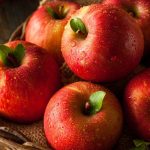 Apple, Fuji – Fuji apples are sweet, crisp, and juicy, with a dense texture, making them a popular snacking apple. They are rich in dietary fiber, vitamin C, and antioxidants, which support digestion, immune health, and skin vitality. Fuji apples can be eaten fresh, added to salads, baked into desserts, or cooked into sauces.
Apple, Fuji – Fuji apples are sweet, crisp, and juicy, with a dense texture, making them a popular snacking apple. They are rich in dietary fiber, vitamin C, and antioxidants, which support digestion, immune health, and skin vitality. Fuji apples can be eaten fresh, added to salads, baked into desserts, or cooked into sauces.
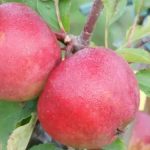 Apples, Stayman – This late-season apple variety is known for its firm texture and spicy, tart flavor with a hint of sweetness. They are high in fiber, vitamin C, and antioxidants, supporting immune health, digestion, and skin health. Stayman apples are excellent for fresh eating and ideal for baking, sauces, and cider, as their flavor intensifies when cooked.
Apples, Stayman – This late-season apple variety is known for its firm texture and spicy, tart flavor with a hint of sweetness. They are high in fiber, vitamin C, and antioxidants, supporting immune health, digestion, and skin health. Stayman apples are excellent for fresh eating and ideal for baking, sauces, and cider, as their flavor intensifies when cooked.
 Grapefruit – Grapefruit is a citrus fruit known for its juicy, tangy-sweet flavor with a slight bitterness. It is rich in vitamin C, fiber, and antioxidants like lycopene, promoting immune health, heart health, and skin health. Grapefruit can be eaten fresh, added to salads, or juiced for a refreshing drink. Store whole grapefruit at room temperature for up to a week or in the refrigerator for up to three weeks.
Grapefruit – Grapefruit is a citrus fruit known for its juicy, tangy-sweet flavor with a slight bitterness. It is rich in vitamin C, fiber, and antioxidants like lycopene, promoting immune health, heart health, and skin health. Grapefruit can be eaten fresh, added to salads, or juiced for a refreshing drink. Store whole grapefruit at room temperature for up to a week or in the refrigerator for up to three weeks.

Lemon – Lemons are tangy citrus fruits packed with vitamin C, antioxidants, and citric acid, which aid digestion, boost immunity, and enhance skin health. They are commonly used to add flavor to beverages, marinades, dressings, and desserts or as a natural cleaning agent. Store lemons at room temperature if using them soon or refrigerate them in a perforated bag to extend their shelf life up to 3-4 weeks.
 Mango – This tropical fruit is known for its juicy, sweet, and slightly tangy flavor. It’s rich in vitamin C, vitamin A, and fiber, supporting immune health, vision, and digestion. Mangoes can be eaten fresh, blended into smoothies, added to salsas, or used in desserts. Store unripe mangoes at room temperature until they soften, then refrigerate ripe ones for up to a week.
Mango – This tropical fruit is known for its juicy, sweet, and slightly tangy flavor. It’s rich in vitamin C, vitamin A, and fiber, supporting immune health, vision, and digestion. Mangoes can be eaten fresh, blended into smoothies, added to salsas, or used in desserts. Store unripe mangoes at room temperature until they soften, then refrigerate ripe ones for up to a week.
Fun Fact: Mangoes belong to the same plant family as cashews and pistachios!
 Orange, Mandarin – These small, sweet citrus fruits have a thin, easy-to-peel skin. They are high in vitamin C, fiber, and flavonoids, supporting immune function, digestion, and heart health. Mandarins are perfect for snacking, adding to desserts, or tossing into salads. Store them at room temperature for a few days or refrigerate to extend freshness for up to two weeks.
Orange, Mandarin – These small, sweet citrus fruits have a thin, easy-to-peel skin. They are high in vitamin C, fiber, and flavonoids, supporting immune function, digestion, and heart health. Mandarins are perfect for snacking, adding to desserts, or tossing into salads. Store them at room temperature for a few days or refrigerate to extend freshness for up to two weeks.
 Orange, Navel – Navel oranges are sweet, seedless, and easy to peel, making them an excellent snack or addition to salads and desserts. They are high in vitamin C, fiber, and antioxidants, which promote immune health and support heart health. Store navel oranges at room temperature for up to a week or refrigerate them in a mesh bag for up to three weeks to maintain freshness. Wash before peeling or slicing.
Orange, Navel – Navel oranges are sweet, seedless, and easy to peel, making them an excellent snack or addition to salads and desserts. They are high in vitamin C, fiber, and antioxidants, which promote immune health and support heart health. Store navel oranges at room temperature for up to a week or refrigerate them in a mesh bag for up to three weeks to maintain freshness. Wash before peeling or slicing.
Organic Veggies We Harvested This Week:
To help you use everything in your box this week, use this Meal Planning Guide to keep track of what’s in the fridge, what needs to be used first, and what you have planned or prepped for each day.
Every member’s customized Market Box is unique so we hope you will take advantage of more varieties of vegetables as you get comfortable with all the great organic produce we are offering.
Tessa’s Tips
What to use first: greens, mushrooms, green onions
Longest Storage: apples, beets, carrots, potatoes
Pro-tip: Look at the items in your market box right away and decide how you will use them in your meal planning for the week. Freeze any veggies you know you won’t be able to eat in the week.
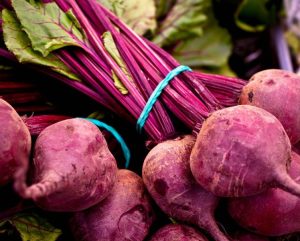 Beet, Red – Red beets are root vegetables known for their earthy flavor and vibrant red-purple color. They are rich in nutrients like folate, manganese, potassium, dietary fiber, and antioxidants such as betalains, which help reduce inflammation and support heart health. Both the roots and greens are edible, with the greens offering additional nutrients like vitamins A and C. Beets can be eaten raw in salads, roasted, boiled, or blended into smoothies and soups. Store beet greens separately from the root, wrapped in a damp cloth or in a plastic bag in the fridge. Use within a few days – they don’t keep long. Beetroots can be stored in a plastic bag in the fridge’s crisper drawer for up to two weeks. To freeze beets for longer storage, slice or chop them, spread on a cookie sheet to flash freeze, then transfer to freezer bags where they can be stored for up to a year.
Beet, Red – Red beets are root vegetables known for their earthy flavor and vibrant red-purple color. They are rich in nutrients like folate, manganese, potassium, dietary fiber, and antioxidants such as betalains, which help reduce inflammation and support heart health. Both the roots and greens are edible, with the greens offering additional nutrients like vitamins A and C. Beets can be eaten raw in salads, roasted, boiled, or blended into smoothies and soups. Store beet greens separately from the root, wrapped in a damp cloth or in a plastic bag in the fridge. Use within a few days – they don’t keep long. Beetroots can be stored in a plastic bag in the fridge’s crisper drawer for up to two weeks. To freeze beets for longer storage, slice or chop them, spread on a cookie sheet to flash freeze, then transfer to freezer bags where they can be stored for up to a year.
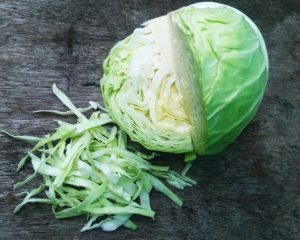 Cabbage, Green – Green cabbage is a nutrient-dense cruciferous vegetable in the Brassica family, known for its tightly packed, round, pale green leaves. It is rich in vitamins C and K, as well as fiber and antioxidants, which are beneficial for immune health, digestion, and bone strength. With a mild, slightly peppery taste, green cabbage can be enjoyed raw in salads and slaws, or cooked in stir-fries, soups, and stews. To store, keep green cabbage unwashed in a perforated plastic bag in the refrigerator’s crisper drawer, where it can stay fresh for up to two weeks.
Cabbage, Green – Green cabbage is a nutrient-dense cruciferous vegetable in the Brassica family, known for its tightly packed, round, pale green leaves. It is rich in vitamins C and K, as well as fiber and antioxidants, which are beneficial for immune health, digestion, and bone strength. With a mild, slightly peppery taste, green cabbage can be enjoyed raw in salads and slaws, or cooked in stir-fries, soups, and stews. To store, keep green cabbage unwashed in a perforated plastic bag in the refrigerator’s crisper drawer, where it can stay fresh for up to two weeks.
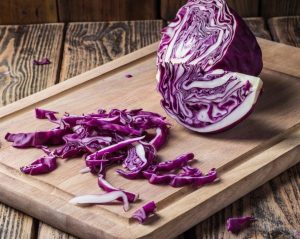 Cabbage, Red – Red cabbage is a vibrant vegetable with a slightly peppery and sweet flavor. It is rich in vitamins C and K, fiber, and antioxidants like anthocyanins, which support immune health, digestion, and reduce inflammation. Red cabbage can be eaten raw in salads and slaws, pickled, or cooked in stir-fries, soups, and stews. Store it in the refrigerator, unwashed, in a plastic bag, where it can stay fresh for up to two weeks.
Cabbage, Red – Red cabbage is a vibrant vegetable with a slightly peppery and sweet flavor. It is rich in vitamins C and K, fiber, and antioxidants like anthocyanins, which support immune health, digestion, and reduce inflammation. Red cabbage can be eaten raw in salads and slaws, pickled, or cooked in stir-fries, soups, and stews. Store it in the refrigerator, unwashed, in a plastic bag, where it can stay fresh for up to two weeks.
Try using red cabbage to make quick pickled cabbage. Thinly slice the cabbage, then toss it with vinegar, lime juice, a pinch of sugar, and spices like cumin or chili flakes. Let it sit for 30 minutes to develop flavor. The result is a tangy, crunchy topping that adds both texture and a pop of color to your meal. Perfect for tacos, burgers, or grain bowls!
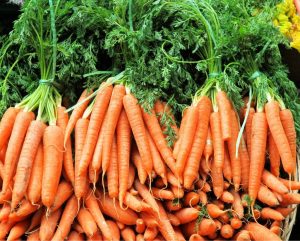 Carrot – Carrots are a versatile and popular root vegetable, known for their sweet, crunchy texture and vibrant orange color, though they can also be found in purple, yellow, and red varieties. They are rich in beta-carotene, which the body converts to vitamin A, essential for good vision and immune health. Carrots are a good source of dietary fiber, potassium, and antioxidants. Enjoy them raw, cooked, roasted, or juiced. They can be used in salads, soups, stews, and side dishes. For optimal storage, store carrots unwashed in the fridge, preferably in a plastic bag or container to maintain moisture, where they can last for several weeks. If the greens are attached, cut them off to prevent the carrots from becoming limp. Stored properly, they should last around 1-2 weeks.
Carrot – Carrots are a versatile and popular root vegetable, known for their sweet, crunchy texture and vibrant orange color, though they can also be found in purple, yellow, and red varieties. They are rich in beta-carotene, which the body converts to vitamin A, essential for good vision and immune health. Carrots are a good source of dietary fiber, potassium, and antioxidants. Enjoy them raw, cooked, roasted, or juiced. They can be used in salads, soups, stews, and side dishes. For optimal storage, store carrots unwashed in the fridge, preferably in a plastic bag or container to maintain moisture, where they can last for several weeks. If the greens are attached, cut them off to prevent the carrots from becoming limp. Stored properly, they should last around 1-2 weeks.

Carrot, Rainbow – In addition to the nutritional benefits above, rainbow carrots stand out from standard orange carrots with their vibrant colors—purple, yellow, red, and white—each offering unique nutritional benefits and distinct flavors. Purple carrots contain anthocyanins, powerful antioxidants linked to anti-inflammatory and heart-health benefits, with a slightly earthy, spicy taste. Yellow carrots are rich in lutein, which promotes eye health by protecting against macular degeneration and cataracts, and they have a mild, subtly sweet flavor. Red carrots contain lycopene, a potent antioxidant that supports heart health, reduces the risk of certain cancers, and helps protect skin from UV damage, with a richer, sweeter taste.
These colorful carrots are perfect for adding visual appeal to dishes and enhancing the taste profile, whether roasted to bring out their natural sweetness, or sliced raw for salads. Their distinct flavors can also add depth to juices and smoothies. The diverse hues, flavors, and nutrients of rainbow carrots make them perfect for garnishes or serving as part of a vegetable medley. Store rainbow carrots the same way you would store standard orange carrots.
 Celery – Celery is a crunchy, low-calorie vegetable known for its mild, slightly salty flavor. It is rich in vitamins K and C, folate, potassium, and fiber, supporting bone health, digestion, and hydration. Celery is often eaten raw as a snack, added to salads, or used as a base in soups, stews, and stir-fries. Store celery in the refrigerator, tightly wrapped in aluminum foil to retain its crispness, where it can stay fresh for up to two weeks. For longer storage, celery can be chopped and frozen.
Celery – Celery is a crunchy, low-calorie vegetable known for its mild, slightly salty flavor. It is rich in vitamins K and C, folate, potassium, and fiber, supporting bone health, digestion, and hydration. Celery is often eaten raw as a snack, added to salads, or used as a base in soups, stews, and stir-fries. Store celery in the refrigerator, tightly wrapped in aluminum foil to retain its crispness, where it can stay fresh for up to two weeks. For longer storage, celery can be chopped and frozen.
Don’t forget to use those celery greens! They’re a great addition to cooked beans, salads, eggs. Use leaves to make pesto or dry them and make your own parsley flakes, powder, or salt.
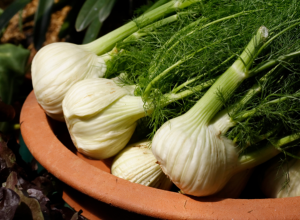 Fennel Bulb – A member of the carrot family, fennel is known for its sweet, anise-like flavor. It is rich in vitamin C, potassium, and manganese. The bulbs can be thinly sliced and added to salads, sautéed, roasted, or grilled. The stalks can be used in soups and stews, and the fronds can be used as an herb-like garnish. Store fennel bulbs in a plastic bag in the crisper drawer, where they can keep fresh for up to a week. If the fronds are still attached, trim them and store them separately wrapped in a damp paper towel inside a plastic bag. For longer storage, fennel bulbs can be blanched and frozen.
Fennel Bulb – A member of the carrot family, fennel is known for its sweet, anise-like flavor. It is rich in vitamin C, potassium, and manganese. The bulbs can be thinly sliced and added to salads, sautéed, roasted, or grilled. The stalks can be used in soups and stews, and the fronds can be used as an herb-like garnish. Store fennel bulbs in a plastic bag in the crisper drawer, where they can keep fresh for up to a week. If the fronds are still attached, trim them and store them separately wrapped in a damp paper towel inside a plastic bag. For longer storage, fennel bulbs can be blanched and frozen.
 Green Onions – Green onions, also known as scallions, have a mild, slightly sweet onion flavor and are packed with vitamins A and K. They are often used raw in salads, salsas, and garnishes but also add depth to stir-fries, soups, and omelets. Their green tops and white bulbs are both edible, making them a versatile ingredient. Store in the refrigerator, wrapped in a damp paper towel inside a bag, or stand them in a jar of water to keep them fresh longer.
Green Onions – Green onions, also known as scallions, have a mild, slightly sweet onion flavor and are packed with vitamins A and K. They are often used raw in salads, salsas, and garnishes but also add depth to stir-fries, soups, and omelets. Their green tops and white bulbs are both edible, making them a versatile ingredient. Store in the refrigerator, wrapped in a damp paper towel inside a bag, or stand them in a jar of water to keep them fresh longer.
 Kale (baby) – Compared to mature kale, baby kale has a milder flavor and more tender leaves, making it ideal for raw applications like salads or smoothies. Nutritionally, it retains the same benefits—rich in vitamins A, C, and K—but may have slightly lower fiber content due to its delicate structure. Store it in a sealed container with a dry paper towel in the fridge and use within a few days to prevent wilting.
Kale (baby) – Compared to mature kale, baby kale has a milder flavor and more tender leaves, making it ideal for raw applications like salads or smoothies. Nutritionally, it retains the same benefits—rich in vitamins A, C, and K—but may have slightly lower fiber content due to its delicate structure. Store it in a sealed container with a dry paper towel in the fridge and use within a few days to prevent wilting.

Lettuce, Loose Leaf – Leaf lettuce, known for its loose, leafy structure and mild, slightly sweet flavor, comes in green and red varieties. It is a low-calorie vegetable packed with vitamins A, C, and K, as well as folate and fiber, making it a nutritious choice for salads and wraps. Its tender leaves are best used raw in salads, sandwiches, or as a garnish. Store leaf lettuce in the refrigerator, loosely wrapped in a damp paper towel inside a plastic bag or container, and use it within a week to maintain freshness and crispness. Don’t miss this exclusive Weekly Salad Greens Subscription in the Lehigh Valley to get the freshest greens every week.
Mushroom Varieties
Store mushrooms in a paper bag or breathable container in the refrigerator, avoiding moisture buildup, and only wash them right before use to maintain freshness.
Mushrooms are super versatile in the kitchen. Here are 10 Things You Should Do With Mushrooms.
This roundup of 20 Mushroom Recipes has you covered with meal ideas for breakfast, lunch, or dinner.
Mushroom, Portobello & Cremini – Portobello mushrooms are mature versions of cremini mushrooms, offering a meaty texture and rich, earthy flavor. Cremini, also known as “baby bellas,” are younger, smaller, and have a firmer texture with a milder taste. Both are low in calories, fat-free, cholesterol-free, and provide B vitamins, selenium, potassium, and antioxidants. Portobellos are ideal for grilling, roasting, or as a meat substitute in burgers, sandwiches, or stuffed recipes. Creminis are great for sautéing, adding to soups, stir-fries, pasta dishes, or as pizza and salad toppings.
Mushroom, Shiitake – Shiitake mushrooms are prized for their rich, umami flavor and slightly chewy texture, making them a staple in Asian cuisine. They are low in calories, fat-free, and a good source of B vitamins, copper, selenium, and immune-supporting polysaccharides. Shiitakes are versatile and can be sautéed, stir-fried, grilled, or added to soups, stews, and sauces for a depth of flavor. They are popular in dishes like ramen, risotto, and dumplings, and are often used in vegetarian recipes for their meaty texture.
💡Tip: The artisan mushroom sampler is a great way to try different varieties of mushrooms. While we can’t predict or guarantee what will be included, the sampler often includes varieties such as enoki, oyster, shiitake, or trumpet mushrooms!
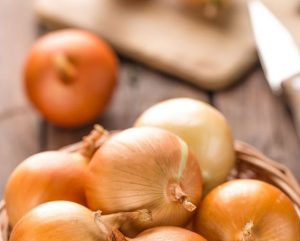
Onion, Yellow – Yellow onions are a popular, versatile vegetable with golden-brown skin and a strong, savory flavor that mellows and sweetens when cooked. Rich in antioxidants, vitamin C, and fiber, yellow onions support immune health, digestion, and overall cellular health. They’re a staple in many cuisines, perfect for sautéing, caramelizing, roasting, and adding depth to soups, stews, and sauces. To store, keep unpeeled yellow onions in a cool, dry, well-ventilated place, away from potatoes, where they can last up to a month; once peeled or cut, store them in an airtight container in the refrigerator for up to a week.
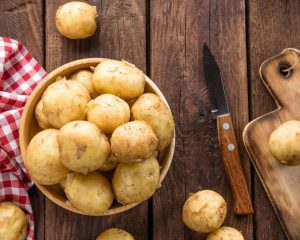 Potato, Yellow – Also known as Yukon Gold or gold potatoes, yellow potatoes have smooth, thin, yellowish skin and creamy, buttery-flavored flesh. They are slightly waxy, making them versatile in cooking. Yellow potatoes are a good source of vitamin C, potassium, and fiber and are low in calories and fat. Their creamy texture makes them ideal for mashing, roasting, grilling, and boiling. They are also excellent in gratins and salads because they hold shape during cooking. Store yellow potatoes in a cool, dark, and well-ventilated place for several weeks, avoiding refrigeration as it can alter their texture and flavor.
Potato, Yellow – Also known as Yukon Gold or gold potatoes, yellow potatoes have smooth, thin, yellowish skin and creamy, buttery-flavored flesh. They are slightly waxy, making them versatile in cooking. Yellow potatoes are a good source of vitamin C, potassium, and fiber and are low in calories and fat. Their creamy texture makes them ideal for mashing, roasting, grilling, and boiling. They are also excellent in gratins and salads because they hold shape during cooking. Store yellow potatoes in a cool, dark, and well-ventilated place for several weeks, avoiding refrigeration as it can alter their texture and flavor.
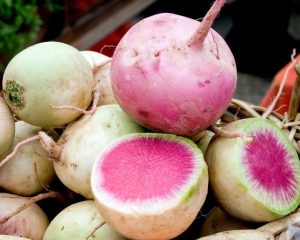 Radish, Watermelon – Watermelon radish is a striking root vegetable with a mild, slightly sweet flavor and a crisp texture. Its pale green skin hides a vibrant pink interior, resembling a watermelon. Rich in vitamin C, potassium, and antioxidants, it supports immune health and reduces inflammation. Watermelon radishes can be enjoyed raw in salads, sliced thinly for garnishes, pickled, or roasted for a milder flavor. Store unwashed watermelon radishes in a perforated plastic bag in the refrigerator, where they can stay fresh for up to two weeks. Wash and trim just before using.
Radish, Watermelon – Watermelon radish is a striking root vegetable with a mild, slightly sweet flavor and a crisp texture. Its pale green skin hides a vibrant pink interior, resembling a watermelon. Rich in vitamin C, potassium, and antioxidants, it supports immune health and reduces inflammation. Watermelon radishes can be enjoyed raw in salads, sliced thinly for garnishes, pickled, or roasted for a milder flavor. Store unwashed watermelon radishes in a perforated plastic bag in the refrigerator, where they can stay fresh for up to two weeks. Wash and trim just before using.
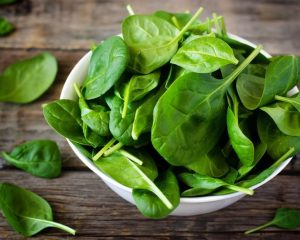 Spinach – Spinach is a nutrient-rich leafy green vegetable packed with vitamins A, C, K, and folate, along with minerals like iron and magnesium. Low in calories and high in antioxidants, it supports eye health, bone strength, and immune function. Spinach is versatile and can be enjoyed raw in salads, blended into smoothies, or cooked in soups, pasta, and omelets. To store, keep it dry in a perforated plastic bag in the fridge’s crisper drawer, and wash only before use. Properly stored, it stays fresh for 5-7 days.
Spinach – Spinach is a nutrient-rich leafy green vegetable packed with vitamins A, C, K, and folate, along with minerals like iron and magnesium. Low in calories and high in antioxidants, it supports eye health, bone strength, and immune function. Spinach is versatile and can be enjoyed raw in salads, blended into smoothies, or cooked in soups, pasta, and omelets. To store, keep it dry in a perforated plastic bag in the fridge’s crisper drawer, and wash only before use. Properly stored, it stays fresh for 5-7 days.
 Sweet Potato – Sweet potatoes are a nutritious root vegetable known for their naturally sweet flavor and vibrant orange flesh, though they also come in other colors like purple and white. They are rich in vitamins A (as beta-carotene), C, and B6, as well as dietary fiber, potassium, and antioxidants. These nutrients support eye health, boost immunity, and promote digestive health. Sweet potatoes are versatile in cooking and can be baked, roasted, mashed, or used in soups and stews. They can also be enjoyed in both savory and sweet dishes. Store sweet potatoes in a cool, dark, well-ventilated place for several weeks, avoiding refrigeration as it can affect their texture and flavor.
Sweet Potato – Sweet potatoes are a nutritious root vegetable known for their naturally sweet flavor and vibrant orange flesh, though they also come in other colors like purple and white. They are rich in vitamins A (as beta-carotene), C, and B6, as well as dietary fiber, potassium, and antioxidants. These nutrients support eye health, boost immunity, and promote digestive health. Sweet potatoes are versatile in cooking and can be baked, roasted, mashed, or used in soups and stews. They can also be enjoyed in both savory and sweet dishes. Store sweet potatoes in a cool, dark, well-ventilated place for several weeks, avoiding refrigeration as it can affect their texture and flavor.
 Sweet Potato, Fingerling – Sweet potato fingerlings are small, slender sweet potatoes with thin, edible skin and a naturally sweet, creamy texture. They are rich in fiber, beta-carotene, and vitamin C, promoting digestive and immune health. Roast, sauté, or air-fry them whole for a crispy skin and tender interior, or slice them into fries or hash. Store in a cool, dry place away from light, but avoid refrigeration as it can affect their texture.
Sweet Potato, Fingerling – Sweet potato fingerlings are small, slender sweet potatoes with thin, edible skin and a naturally sweet, creamy texture. They are rich in fiber, beta-carotene, and vitamin C, promoting digestive and immune health. Roast, sauté, or air-fry them whole for a crispy skin and tender interior, or slice them into fries or hash. Store in a cool, dry place away from light, but avoid refrigeration as it can affect their texture.
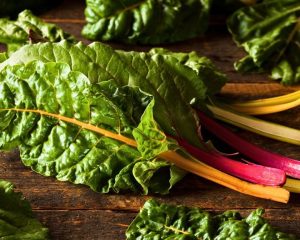 Swiss Chard – Swiss chard is a vibrant leafy green vegetable, rich in vitamins A, C, and K, as well as magnesium, potassium, and iron, making it a nutritious, low-calorie option. The stems come in various colors or simply a whitish green. Both the leaves and the stalks are edible. When picked very young, chard can be part of a green salad. But full-grown chard like in your box today has a very strong flavor and tough stems when eaten raw. Its slightly bitter, earthy flavor pairs well with garlic, lemon, and olive oil, and it can be sautéed or steamed. After cooking for several minutes, it can also be added to rice and beans or omelets. Chard can be sliced or chopped and added to soups. The stems work well in soups, stews, or as a celery substitute. Use Chard any way you would prepare spinach, allowing for longer cooking time for the stems. To store, keep unwashed in a plastic bag or container in the refrigerator’s crisper drawer, using it within 3–5 days; if it wilts, revive it by soaking in cold water before use. Before using, wash well in cool water and separate the leaves from the stems.
Swiss Chard – Swiss chard is a vibrant leafy green vegetable, rich in vitamins A, C, and K, as well as magnesium, potassium, and iron, making it a nutritious, low-calorie option. The stems come in various colors or simply a whitish green. Both the leaves and the stalks are edible. When picked very young, chard can be part of a green salad. But full-grown chard like in your box today has a very strong flavor and tough stems when eaten raw. Its slightly bitter, earthy flavor pairs well with garlic, lemon, and olive oil, and it can be sautéed or steamed. After cooking for several minutes, it can also be added to rice and beans or omelets. Chard can be sliced or chopped and added to soups. The stems work well in soups, stews, or as a celery substitute. Use Chard any way you would prepare spinach, allowing for longer cooking time for the stems. To store, keep unwashed in a plastic bag or container in the refrigerator’s crisper drawer, using it within 3–5 days; if it wilts, revive it by soaking in cold water before use. Before using, wash well in cool water and separate the leaves from the stems.
Fun fact: Chard is in the chenopod family which includes beets, spinach, and quinoa.
Don’t Forget: Online shopping opens Friday at 1 PM! 🛒 Stock your kitchen with these clean, nourishing ingredients to fuel your family with nutrient-dense meals. Be sure to grab your favorite staples and try something new for vibrant health this winter.
Don’t wait to join…
Veggie E-Books
Download these collections of tips and recipes for each veggie. You’ll use these as a reference throughout the season.
Beets E-Book
Cabbage E-Book
Carrots E-Book
Kale E-Book
Lettuce E-Book
Mushrooms E-Book
Onions E-Book
Potatoes E-Book
Radish E-Book
Scallion/Green Onion E-Book
Spinach E-Book
Swiss Chard E-Book
~~~~~
We’ll keep farming for you!
Reuben and Tessa DeMaster
Willow Haven Farm


